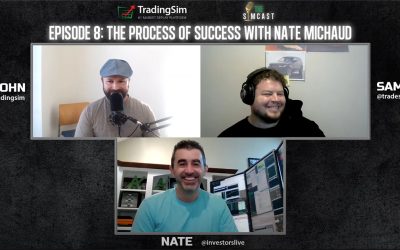15 Trade Management Tips to Improve Your Trading
Trade management is an important part of the trading process. It's not enough to have an effective strategy - you also need to execute that strategy properly. Think of this distinction as the difference between creating a well-rounded business plan and actually...








Great video Nate, VERY educational please do more videos like this. I have a small account so I just enter my full size (300-500 shares) without scaling in mainly because I didn’t know how to but this video helped me understand a little.
I understand that onclose, scaling is something I see Nate do, and yet I also am in a similar boat as you, in the fact that I usually lay my main position 500-1000 shares at the onset of an entry. Scaling out, however is something I try to get better at… the thing lately for me is that as I enter on a “C” of and “ABCD” text book long, I have found that the times I take profits early as I get a 1:1 risk reward, I find that I am showing consistency. I know that is not necessarily as NAte teaches and shows with the scaling in this video, but I can try to find out what part of these methods I can see in action, and dove tail for myself as I can find some path way to consistency..which is the thing I am trying to do.. I woudl like to hit a few doubles but i don’t a lot of the time, I really notice how wise nate sorta accepts blurred out trades he might make in an effort to catch the fullest of the chart set up… I may be able to get there, but in short, I think you can be consistent doing what you do with size, and wise entries. I also don’t always scale out, I sometimes just take my profits at 1:1 rr , and let the fact that the probablity of my entry is the key , adn I mean the KEY to breaking past 50/50, I also think I can learn to tell early when a trade is not going to work out and get out.
I’m always looking for ABCD setups but I can never spot them I guess you have to have a trained eye to spot that pattern
YES- ON close, thats been the case for me. Exactly, it is just like learning another language, or skill at a job, it really takes some effort and patience.. I am not a smart A student, I got C’s in college and barely finished. I drive a cab now. I do know that I learn through a lot of repetion, almost like a baby. So I listen to Textbook Trading (mostly on the meat of the DVD from 1 hour -5 hours) over and over , almost every day while I am looking at my platform, adn drive a cab at night. I have been at this day trading game for 2.7 years…and still take in new material , compare materials, and look for waht works in other methods, and what doesnt’, and waht I see, and what others see.. and I keep working hard at it… adn I know that at any day, I can drop out of the school fo life if I don’t keep working at this, applying it, reviewing, and takign note to change.. that is hard.. I know life balance is key too, so I keep a 3-4 day workout at the gym routine, watch my diet as best as I can, and make sure to keep making time to enjoy relationships with others for relationships sake. All work no play , makes jack a dull boy, and that can go on in a traders life for sure. so that is what I have learned to date. Nate does stuff I can’t imagine doing, he is highly versatile trader, and I look forward to the way IU may change to accomodate more one one teaching adn mentoring allowing interested folks to really just zero in on one key area, and have break out sessions by experinenced consistent traders who are able to point out what the pattersn are, how they work, how they fail, how to keep ones head up, and even suggest ways to improve the specific skill set an help the trader understnad thet time needed to carve out to do it, and balance life.. just my humble opinion..
AT 8:01-8:18 on the video lesson.. .please correct me if I am wrong.. but did I notice that $SPI had that ABCD action going on from the 10:35-36am area, based on the prior 20 minutes from that 10:35 time on the chart? Would I be correct with text book trading type of thinking… in the case one got long on that “C” leg at near 1.95/96 at around 10:39, that they would have caught that move upto 2, (whole number mark) , but have a failed break through “D”.. and in such case as that, could the trader have been able to anticipate that gap down after the second $2 test ? perhaps scratch the trade or small loss/gain/even ? Also, as I am learning more about the niche set ups that I can at least start to perhaps break into ‘consistency’ land.. I ask these questions as I know text book trading has more that just the ABCD ( like shorting parabolic)… I looked back over my MAY paper trades, and I found that I was actually reaching the fullest consistency in just doing longs on ABCD moves, and waiting for the confirmation of the C area to really take root.. and not anticipate the C by getting long on B.. which is tempting to do premature C area entries.. The problem I run into is focusing on the screen for such a time, knowing that nothing sets up that I am able to catch.. while I fully have May’s review and track record that clearly shows me that is my sweet spot, and I Am not making money on the lure to scalp morning opens, chase, just risking r/g g/r, and get in long on just the fact of a weak open and daily chart set up, is still not something I understand, but when I see you do it, I want to learn it, so I can have a trade working earlier on, rather that staring and not ‘having any EDUCATED action’ not over trading, but a larger skill base to do more that wait out the ABCD moves for a C set up ( * with maybe some r/g, half whole dollar marks, multiple time frame – 1 m, 2 m, 5 min, 15 min daily -) – Another main skill set I am looking for is being able to tell quicker, with higher accurate anticipations, when the trade I put on is not working out? the thing lately for me is that as I enter on a “C” of and “ABCD” text book long, I have found that the times I take profits early as I get a 1:1 risk reward, I find that I am showing consistency. And I want to be able to have more skills to ‘know when to hold ’em’ That will be a great day when I am able to see the how and why I would be wanting to do that in a trade that I get in on a C part of the move